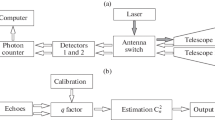Abstract
Results of field experiments on horizontal paths using the BSA-2 and BSA-3 turbulent lidars, principles and design of which have been described in the first part, are presented. The BSA-2 lidar operated on 2-km path together with an independent image jitter sensor (IJS); and the BSA-3 lidar, on a horizontal 26-km path. The BSA-2 lidar was used in the experiments aimed at the study of the shape of the backscatter amplification peak, which was found to be 6.5 μrad in our experiments; the sounding was performed with apertures of different sizes. The experimental dependence of the q factor of the effect of turbulence on the size of receiving aperture is derived, which agrees satisfactorily with the Vorob’ev formula. The lidar sounding data and results of the data conversion into the structure parameter of the “optical” turbulence С 2 n with the use of the Vorob’ev approximation for homogeneous turbulence are presented. The sounding range was ~10 km. The coefficient of correlation between lidar and IJS data is 0.7–0.8. The sounding in urban environment showed that a horizontal path is not statistically homogeneous; therefore, more complex procedures are to be used for the retrieval of the structure parameter С 2 n when solving the inverse problems of lidar sounding of turbulence.
Similar content being viewed by others
References
I. A. Razenkov, “Turbulent lidar. I. Design,” Atmos. Ocean. Opt. 31 (3), 273–280 (2018).
V. A. Banakh and I. A. Razenkov, “Lidar measurements of atmospheric backscattering amplification,” Opt. Spectrosc. 120 (2), 326–334 (2016).
I. A. Razenkov, “Low-cost continuously operating image jitter sensor with a 2-km base,” in Proceedings of the XXII Intern. Symp. “Atmospheric and Ocean Optics. Atmospheric Physics” (Publishing House of IAO SB RAS, 2016), p. B241–B244 [in Russian].
V. V. Vorob’ev, “On the applicability of asymptotic formulas of retrieving "optical” turbulence parameters from pulse lidar sounding data: I—Equations,” Atmos. Ocean. Opt. 30 (2), 156–161 (2017).
V.V. Vorob’ev, “On the applicability of asymptotic formulas of retrieving "optical” turbulence parameters from pulse lidar sounding data: II—Results of numerical simulation,” Atmos. Ocean. Opt. 30 (2), 162–168 (2017).
P. A. Konyaev, N. N. Botygina, L. V. Antoshkin, O. N. Emaleev, and V. P. Lukin, “Passive optical methods in measurement of the structure parameter of the air refractive index,” Atmos. Ocean. Opt. 28 (6), 522–525 (2015).
A. S. Gurvich, A. I. Kon, V. L. Mironov, and S. S. Khmelevtsov, Laser Radiation in Turbulent Atmosphere (Nauka, Moscow, 1976) [in Russian].
V. V. Vorob’ev and A. G. Vinogradov, “Effect of background turbulence in lidar investigations of clear air turbulence,” Atmos. Ocean. Opt. 27 (2), 134–141 (2014).
A. G. Vinogradov, Yu. A. Kravtsov, and V. I. Tatarskii, “The effect of intensification of back scattering by bodies that are situated in a medium having random inhomogeneities,” Radiophys. Quantum Electron. 16 (7), 818–823 (1973).
V. A. Banakh and I. A. Razenkov, “Refractive turbulence strength estimation based on the laser echo signal amplification effect,” Opt. Lett. 41 (19), 4429–4432 (2016).
V. A. Banakh and V. L. Mironov, Radar Propagation of Laser Radiation through Turbulent Atmosphere (Nauka, Novosibirsk, 1986) [in Russian].
Author information
Authors and Affiliations
Corresponding author
Additional information
Original Russian Text © I.A. Razenkov, 2018, published in Optika Atmosfery i Okeana.
Rights and permissions
About this article
Cite this article
Razenkov, I.A. Turbulent Lidar: II−Experiment. Atmos Ocean Opt 31, 281–289 (2018). https://doi.org/10.1134/S1024856018030120
Received:
Published:
Issue Date:
DOI: https://doi.org/10.1134/S1024856018030120



